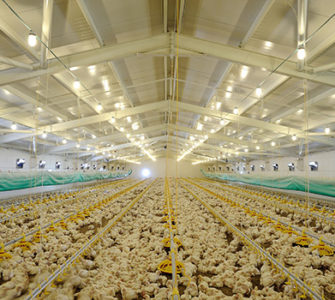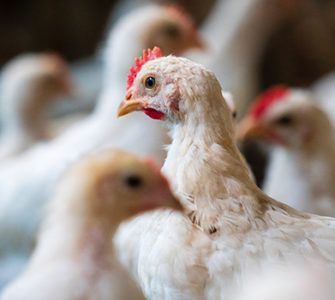Get to know the lesser-known risk factors of necrotic enteritis in broilers
By
John A. Smith, DVM, MS, MAM
Alectryon LLC
Baldwin, Georgia
Demand for chicken raised without antibiotics is increasing in the US. It’s a trend driven largely by marketing competition among quick-service restaurants and upscale grocery retailers responding to anti-industrial-agriculture activist groups. While the poultry industry deserves high marks for meeting the market’s shifting demand, the increased demand for poultry from antibiotic-free production systems has been accompanied by a rise in the incidence of necrotic enteritis (NE) — not just in the US but in Europe, too, where so-called growth-promoting antibiotics were banned by legislative fiat.
Fortunately for our industry, an increase in poultry-production problems is often followed by increased research activity and publication. For example, the May-June 2016 issue of Avian Pathology was entirely devoted to the 2015 International Conference on Necrotic Enteritis in Poultry. In the preface to this issue, symposium editors documented the rising number of publications about NE; citations in PubMed for “necrotic enteritis and chickens” increased from less than four per year prior to 2003 to a peak of 20 to 30 citations per year since 2009.[1] In this comprehensive symposium, numerous authors stressed that much more is now known about the etiology, pathogenesis and control of NE, and particularly about predisposing conditions and risk factors for the syndrome. They stressed, however, that much remains to be discovered.
Future hopes for NE control in the post-antibiotic era hinge on new knowledge about the pathophysiology of the disease — that is, the nuts-and-bolts of the disease process within the bird — and potential methods of disrupting those pathological processes, including gut-microflora management, novel vaccine approaches and non-antibiotic therapeutic or “nutraceutical” agents. Getting a clearer picture of flock management and environmental risk factors will be equally important but, to date, have been poorly explored methods of control.
Predisposing factors
Net-B-positive virulent strains of Clostridium perfringens are now accepted to be the proximate or most recognized cause of NE lesions. It’s also clear that the Net-B organism is usually ”necessary but not sufficient.” In other words, it doesn’t generally cause the disease by itself. Other predisposing factors are typically involved in field cases, where some additional gut insult is necessary to allow proliferation and oral migration of toxigenic strains.
Widely accepted predisposing factors include coccidiosis and high protein and/or poorly digestible protein diets, with fish meal being the classic example used in disease models. Small grains such as wheat, oats, barley, rye, etc. that have a high level of non-starch polysaccharides have been linked to proliferation of C. perfringens.
Other accepted predisposing factors for C. perfringens include anti-nutritional or irritating agents such as mycotoxins, biogenic amines and rancid fats, and immune suppression from agents such as infectious bursal disease and chicken anemia virus. Features of these predisposing factors include gut epithelial damage, maldigestion/malabsorption, serum leakage and mucin production, which lead to increased protein availability in the distal gut that favor C. perfringens proliferation. The result is deranged gut motility and throughput, changes in viscosity of the chyme, unfavorable alterations in normal flora and immune suppression. These conspire to cause a bloom in the Clostridial population, oral migration and toxin elaboration.
Vaccine trials
There are two lesser-known management and environmental issues that became apparent during the summer of 2012, when I was involved with a series of three prospective trials to compare various coccidiosis vaccines then available in a large population of birds raised without antibiotics. Despite the use of several “antibiotic alternatives” — including two enzymes, an encapsulated butyric acid product, a Bacillus subtilis direct-fed microbial, an oregano product, a mannan oligosaccharide and a soluble fiber product — severe problems with NE occurred in the first flocks placed on the vaccine program and continued throughout the three trials.
A reporting scheme for NE cases was then implemented. The resulting data were used not only to compare the vaccines but also to attempt to identify management and environmental factors we might be able to control to lessen the NE problem. Flock supervisors were trained to recognize the typical “dirty Turkish towel” lesion. Any house where mortality exceeded 2/1,000 head placed/day and where the typical gross lesions were noted in dead birds was to be reported as a case. Flocks with mortality < 2/1,000/day would by definition be considered subclinical and were not recorded, but undoubtedly occurred. Supervisors were provided with reporting forms that had fields for data input, including the age at which signs began and peak daily mortality.
At the onset of the second trial, about one-third of the way through the series, a second starter feed containing 113 g/t of the coccidiostat amprolium was fed from about 10 to 18 days of age, which immediately reduced the NE incidence to about 30% of the incidence in trial 1, but the issue remained. The incidence of NE during trial 1, where we used antibiotic alternatives but no amprolium, was approximately 15.75% of houses placed. The incidence of NE in trials 2 and 3 with amprolium was 5.12% of houses placed.
Three of the vaccines exhibited roughly similar overall disease losses, while one vaccine demonstrated both higher incidence and severity. There were no clear differences among the four vaccines in overall performance parameters such as livability, condemnation, growth rate, feed conversion or production costs when the flock settlements for each group were collected and averaged, and the normal gradual improvement over summer was factored in. Over all trials, the average age of onset was 16 days, with a range of 11 to 28 days of age (Figure 1). The peak daily mortality for all cases in all trials averaged about 5/1,000/day, with a minimum of 2/1,000/day (by case definition) and a maximum of 27/1,000/day.
Significant management factors
Two management factors were identified that had a very significant impact on the incidence of NE: the type of litter — new versus used — and bird breed.
Litter type: Wet litter is a well-known predisposing factor for NE. The presumed effect is enhanced coccidial cycling and possibly increased bacterial proliferation of unfavorable species (perhaps including Clostridium) in the litter.
Many clinicians have recognized that new litter may be a risk factor as well. “New house syndrome” has been used to describe the perception that performance shortfalls and gut-health problems, including coccidiosis and NE, seem to be more common in brand-new houses.
Indeed, it’s my perception that some of the more serious problems raising chickens without antibiotic use have occurred in new houses or in houses that were cleaned to the ground and/or laid out for an extended period (months) due to remodeling, grower illness, etc. In these trials, 18.39% of all flocks in the population were housed on new litter, but that group accounted for 36.96% of the cases or double its share of the population (Table 1). The odds of NE were 2.6 times higher in flocks housed on new litter (95% confidence interval 2.08-3.26, P < 0.0001 by Chi-Square test).
Table 1. Effect of litter type on incidence of NE
| Litter type | NE absent | NE present | Totals |
| New | 645 | 136 (37% of cases) | 781 (18.4% of the total population) |
| Built-up (used) | 3,234 | 232 (63% of cases) | 3,466 (81.6% of the total population) |
| Totals | 3,879 | 368 | 4,247 |
The relationship between new litter and NE is unknown and it would be very useful if elucidated. Hypotheses might include the fact that new litter is less absorbent and therefore tends to get wet; perhaps the normal flora in used litter has a protective effect or perhaps used litter results in more even and protective cycling of the coccidiosis vaccine. Of course, there may be other unknown factors in operation.
Breed and/or hen flock age: During the course of the trial, the population was derived from one female breed, but we were in the process of transitioning from one male breed to another. Over the trial period, the population was comprised of 57.4% of the old breed cross and 42.6% of the new breed cross.
The old cross was represented by older hen flocks, so the exact effects of hen flock age and breed cannot be separated. The older breed cross, in spite of supplying 57% of the flocks, accounted for 83% of the cases (Table 2). The odds of NE were 3.97 times as great in flocks comprised of the older breed cross (95% confidence interval 3.00-5.24, P < 0.0001 by Chi-Square test). This remarkable pattern suggests that breed (or hen age, which seems less likely) may have a profound impact on NE.
Table 2. Effect of breed (or hen age) on incidence of NE
| Breed cross | NE absent | NE present | Totals |
| A x C (older) | 2,118 | 305 (82.8% of cases) | 2,423 (57.4% of the total population) |
| B x C (younger) | 1,735 | 63 (17.2% of cases) | 1,798 (42.6% of the total population) |
| Totals | 3,853 | 368 | 4,221 |
In summary, we still need better therapeutic tools to help prevent and treat NE, but management factors can have a profound impact. Determining additional significant management factors that contribute to NE would be valuable information to have.
Dr. Smith was formerly director of health services for Fieldale Farms Corporation.
Document number POU-00017
[1] Van Immerseel F, et al. Editorial. Recent breakthroughs have unveiled the many knowledge gaps in Clostridium perfringens-associated necrotic enteritis in chickens: The first International Conference on Necrotic Enteritis in Poultry. Avian Pathol. 2016;45:269-270.
Posted on November 10, 2016


















